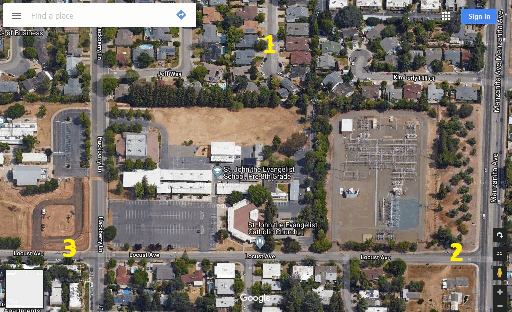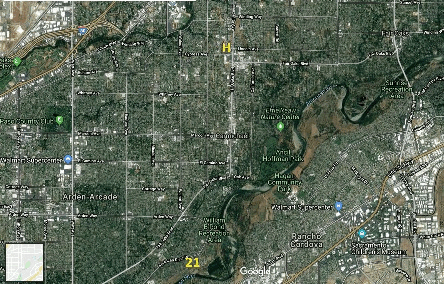|
For every cause there is an effect. For every effect there must have been a cause. It is an immutable law of matter. EAR’s attack on Victim 21 in Sandbar Circle in the early morning of May 17, 1977, has always stood out within the large dossier of EAR’s abominable crimes. He was agitated, threatening, and more terrifying than usual. Until the recent info dump by the Sacramento County Sheriff’s Department (February 27, 2018), there was no explaining why the East Area Rapist behaved as he did with his victim. Now with the release of the Haskell Avenue Incident of late night May 16, 1977, only a few hours before he invaded the home of G and P, we have the ability to follow a logical progression.
Let’s let the Sheriff present the case first.
A little past 11:00 p.m., May 16, 1977, a twenty seven year old man and his wife were at there residence in the 5700 block of Haskell Avenue in Carmichael, CA. The man was in his family room watching television, when he glanced up and saw a man outside looking inside the residence through a kitchen window. The resident got up as the man ran from the window, but by the time he reached the area, the suspect was jumping a fence into an adjacent property. The resident noted the suspect to be very athletic as he jumped a six-foot fence by grabbing the top of the fence with only one hand and easily vaulting over. The resident gave chase, but lost the suspect. He described him as a white male, 5'9" to 5'10" tall with dark hair, a dark jacket, and Levis jeans. He was wearing tennis shoes.
Sacramento Sheriff's deputy Marlin Weinberger arrived quickly, and while speaking with the resident, the resident pointed to an area between two nearby houses and indicated he saw the suspect . He again gave chase. Deputy Weinberger also chased the suspect in the direction the resident pointed, and the resident broke off the chase.
The chase led to an electrical transformer substation at the intersection of Locust Avenue and Manzanita Avenue. Deputy Weinberger believed the suspect was hiding nearby, and attempted to hail a motorist who had pulled away from the curb on Locust Avenue near an apartment complex. Deputy Weinberger hoped the motorist could shine his headlights into a nearby field and illuminate it. As Deputy Weinberger stood in the street flagging the motorist down, the motorist sped up and swerved around the deputy, fleeing the area. Deputy Weinberger realized the suspect was probably the man in the vehicle, but was now far away from his Sheriff's patrol car. The suspect escaped. The driver was described as a white male with a dark jacket on, and the vehicle was described as a red, 1967-1970 Toyota or Datsun. Deputy Weinberger looked at several possible vehicle models and included them in his report.
Several additional units arrived, and an extensive search was launched for the car and its driver. Meanwhile, Deputy Weinberger found the residence next door, a newly constructed residence that was still unoccupied, had been forcibly entered via a sliding glass door. The resident who chased the suspect indicated he had locked the newly constructed residence up himself earlier in the evening. Deputy Weinberger was taken to an airfield where he was picked up by a helicopter to attempt and locate the car or driver, but was unable to locate either.
A couple of hours later, at 1:30 a.m., May 17, 1977 the East Area Rapist would strike a couple in the 1100 block of Sandbar Circle in the Del Dayo Area, a little over five miles away. During that crime, the suspect was very agitated and was described as "crazy" by the victims. For the first time in the series, he made wild comments regarding his hatred for law enforcement, referring to them as "pigs," and for the first time threatened to kill two people and demanding the victims tell the "pigs" what he said. Neighbors indicated they heard a foreign sounding vehicle make a U-turn and then depart the court at approximately 11:15 p.m. The neighbors also indicated a dog was barking excitedly at 11:30 near the crime scene.”
This is the gist of the case. We will interrupt it here. It is concise, streamlined, and gives us an understanding of EAR’s behavior with Victim No 21.

Haskell Avenue (1), the power substation and corner of Manzanita and Locust (2), and where EAR pulled out from on Locust (3) in context.
EAR’s frenzy with his victim that night was merely the crescendo of the month’s mania. This May he would strike 5 times, and from this incident we see that 5 only represents a fraction of the times he was prowling, and the number of victims only a fraction of those he had selected. This guy spent all his time at his grim “hobby” of terror.
This is underscored by other reports of that night. As early as 9:30 p.m. a neighbor in Sandbar Circle had seen some prowler shining a flashlight beam into the (future) victim’s property and thereabouts, but did not call the police. In addition to this, dogs had been barking around the neighborhood indicating something had been agitating them from house to house and yard to yard— the tell tale sequence that indicates a prowler moving through yards.
It would seem that EAR then left the neighborhood and went north on Manzanita to scope the area of Haskell Avenue. Having failed up there he bee-lined it back to Sandbar Circle. If the times above are accurate, he must have darted back down south on Manzanita after swerving to miss Weinberger in order to get to Sandbar Circle by 11:15 p.m.

Haskell marked with an “H” and Sandbar Circle marked with “21”.
The avid follower of the case can immediately register this. Everything garnered about EAR’s Stalking MO indicates that the number of strikes he made represent only a fraction of the time he spent prowling a neighborhood. This is, of course, a clue to the amount of time he had on his hands to spend, and this cascades to indicate either he didn’t work or he had a profession with no oversight that allowed him to spend this kind of time at night in neighborhoods.
The Haskell Avenue Incident ably underscores this for us once again. But unlike the other incidents we are given a clear description by a trained observer of EAR’s car. In almost every other case, the East Area Rapist’s car had to be identified by tire tracks (and then assumption it was his car) or from sounds of the engine after the victims heard it start, and most unreliably from reports of neighbors gathered during after-the-fact canvassing stating that such and such an unknown car had been seen cruising the neighborhood.
These last type of reports are what have impelled me into my theory of auto-wrecking, but the Haskell Avenue Incident may add a new dynamic. His car here, in fact, is potentially as vital to identifying EAR as the sketch from Victim 15 is to trying to grasp the imp’s facial features. This is the only time in situ that his car was seen! This is incredibly important for more than one reason. The first is the context.
From the Sheriff statement we are given this picture. This is what deputy Weinberger selected as the car he had encountered.

The above compares a Datsun 510 and a Toyota Corona.
There are many factors here which confirm for us this was EAR driving this boxy Japanese car. One, the car pulled out from the curb by an apartment complex. We have already dealt with that in another analysis section. This was EAR’s way of blending in. Parked with other cars crowding the sidewalk by an apartment complex wouldn’t attract attention to his car. Bloodhounds had traced EAR’s scent for quite a distance in other cases, indicating he frequently parked away from the street he intended to prowl. This is corroborated here. He parked on Locust and moved through the church property or field and jumped fences to enter the backyards of Haskell Avenue. Bloodhounds and canvassing also proved that on the night of the attack he usually parked very close. This is also confirmed that night. When he struck on Sandbar Circle later that night, he had parked almost right by the victim’s house.
Although this underlines for us that EAR was the perp in each incident that night, this should cause us to question how often, if at all, did EAR actually ever drive an intended neighborhood before-the-fact. Understanding his MO, we see it isn’t even necessary that he did drive the actual street except on the night of the attack (during the earlier prowler reports on Sandbar Circle at 9:30 p.m. no one reported a foreign sounding car cruising or starting). Maybe in the very beginning, just once he drove the street. But put all together and it seems that EAR did not frequently drive the intended street nor did his MO require he drive a community’s streets.
The canvassing information that for years has given us the reports of many “suspicious” cars could be false leads. These cars may merely have been cars driven by other young men visiting the neighborhood. It is a bit of a digression here, but it does help to accentuate the importance of the fact this car was identified by a qualified observer. The young men associated with the other “suspicious” cars in daytime are often described as young, blondish, and this has given us most of the sketches and our impressions of EAR’s appearance. But the witness this night on Haskell Avenue gives us the rare description of dark brown hair. This was reported only a few other times, and each time it was by a witness while EAR was in perpetration. This Incident should help define EAR.
We must then ask, is the Datsun or Toyota the car he most frequently used and the others are red herrings? Here in the Haskell Avenue Incident all elements come together to indicate this was EAR and this was his car.
From deputy Weinberger’s description during that near miss we have a choice of two cars. And with this two interpretations. The first choice is a 1970 Datsun 510, considered Datsun’s first world car. As you might gather this is the model that made them a world car franchise (later to be called Nissan). For low income, gas-money-conscious and young, this was likely a premier choice. In 1977 this particular 1969/1970 model could have been 7 or 8 years old. Not an age associated with a “jalopy” that might have been turned in for wrecking or parts. Since it is not reported as banged up, I doubt it was something primed for a wrecking yard. However, most of the auto wreckers boasted of a large selection of foreign and domestic used cars. Still, this popular Datsun was truly not that old. This could suggest it was a personal car.

The other choice is an earlier Toyota Corona— very similar and in some ways more boxy. It could have been as much as 10 years old, and from that era that would be an old car. Styles changed more rapidly and starkly back then, and people were more fashion conscious. This is something that could be on a used lot or behind a wrecker’s cyclone fence as a used car.

One thing we should not doubt: this was EAR. His use of empty or newly built homes is quite established, and the Haskell Avenue Incident contains this clue too. His prowling had previously identified them as a base of operations or he had some other means by which he knew a house would be empty. He seemed to know where the newly constructed homes were.
Prowling had existed in Sandbar Circle earlier that evening. Then later that night or early next morning EAR returns there and is very agitated. This subsequent behavior at Victim 21 tells us he had become agitated for some reason, one especially aimed at the “pigs,” and the Sheriff rightly calls our attention to the cause and effect here. We also know from other EAR incidents that he did not quit. One would think with a chopper in the area he would retire for the night or strike somewhere much further away. In fact, he had only driven down Manzanita to Del Dayo. Obviously, he had already selected the victim here previously and she was now used as the alternate. Everything, even little clues like the earlier prowling in Del Dayo, seem to fit together in logical progression and connect EAR to both incidents.
One description given by the Haskell Avenue witness suggests EAR the most— the fence jumping. His description of dark hair also supports my own personal view that the many sketches purporting to be of a blond EAR really show some young man unconnected to the crimes in the community.
The events that follow in the Sheriff report must be taken cautiously. They reveal an unrelenting predator (which we know EAR was), but the chain of events we now encounter could be the acts of a crank or prankster. Nevertheless, we know EAR was this confident at this time that he might dare something like this. In his vengeful spite he may have had the guts to come back and do the following.
The Sheriff Statement continues:
Tuesday, May 17, 1977, the morning following the prowler incident and the chase, the residents of Haskell Avenue who were victimized the prior night by the prowler left their home at 7:30 a.m. to go to work. When the man came home for lunch at around noon he found a threatening note stuck in the front door of his residence. The note was written on a religious booklet titled "Four Spiritual Laws." In block lettering that appeared to have been made with a straight edge was the phrase, "Allmost had me next time you die." The phrase was printed on successive pages in ink.
With this development, the resident who had chased the prowler felt his family was clearly being targeted. He had an alarm system installed by a local company on Saturday, May 21, 1977. When the workman had finished, the man's wife swept up the laundry room where the install had occurred. The following evening, Sunday, May 22, 1977, the man and his family went bowling at 5:45 p.m. This was the first time they had been gone on a Sunday evening, and prior to leaving the man activated the door alarms and locked the home up. Upon returning at 8:50 p.m., the man's wife noticed there was plaster dust on the washing machine and a sheet metal screw on the wash room floor directly below a ceiling attic entrance. She was positive this was not there when they left as she had thoroughly cleaned up when the alarm installers left. A check of the house found all the windows and doors secure except one. The master bathroom window was standing open and the screen was damaged. This window had been secured prior to leaving. Nothing was missing from the residence, and nothing else was disturbed. Responding CSI units located and photographed several herringbone patterned shoeprints on top of the washing machine.
The residents did not report any additional problems after the burglary.
Again, the reader who has followed this case automatically knows that EAR had used herringbone sole tennis shoes in several of his strikes, this proved by finding the prints in the garden area. They were size 9. The pamphlet is something he could have picked up during his prowling, even off of the doormat of a home somewhere.
If this was EAR, I can’t imagine what he was trying to do on the washing machine except make it look like he was going to hide in the attic storage area. It was a terror ploy by whoever did this. He was also right by the install of the new alarm. How did he know this was installed?
If this was EAR coming back to terrorize the Haskell Avenue witnesses household then one cannot help but be stunned at how careful he was, even in what appears to be sloppy prowling, but also how bold in that he was so unrelenting. We can all well understand why so many victims are alive today to speak of him, but few come out to do so. This is not only an incredibly haughty villain but a cunning, shrewd vengeful one as well.
EAR acted this night like a maniac. This is at a contrast to most impressions that he was a very cool, calculated prowler and predator. It took just this one chase during this frenzied month, one encounter with a deputy pursuing at a distance (Weinberger was at the field and EAR was already in his car up the block, so he had easily outdistanced him), and then a fleeting glimpse of the same deputy in his headlights doing nothing more than trying to wave him down, to set EAR off into a “crazy” rage later.
Yet he remained undeterred and struck his previously scoped victim, never disturbed the father-in-law or children in their beds, and silently got away.
Where had EAR been in the interim, that is, in the span between the Haskell Avenue Incident and the 1:30 a.m. invasion of Victim 21’s house? It is hard to understand the timetable of one paragraph in the Sheriff statement. The Haskell Avenue incident occurred a little after 11 p.m and must have played out over close to 20 minutes. Yet the release says that a foreign sounding car was heard to pull in and drive out of Sandbar Circle at 11:15 p.m., which seems too soon. The attack on Victim 21 did not occur for a couple more hours. It lasted until close to 4 a.m. when the husband got free with the help of his father (asleep in one of the guest bedrooms).
Where had EAR gone for those couple of hours? Certainly somewhere where the chopper wasn’t circling overhead. Did he switch cars or did he boldly venture out again in his little red boxy Japanese car?
Where was the lair? Or was there even one in the East Area? A boxy Datsun would turn up again in other reports. In one case it was white. It is time to look at all the cars reported involved in “suspicious” behavior.
|